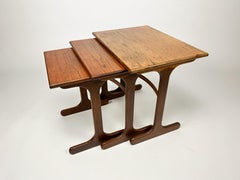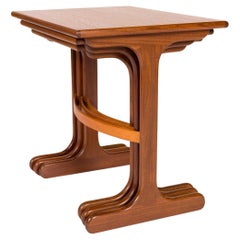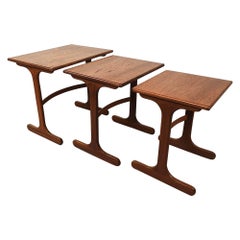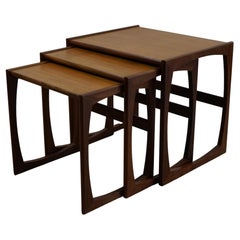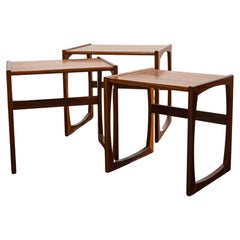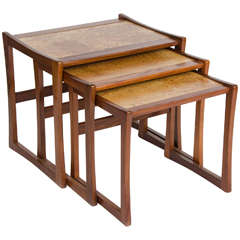G Plan Nest
Vintage 1960s European Mid-Century Modern Nesting Tables and Stacking Ta...
Teak
Mid-20th Century British Mid-Century Modern Side Tables
Teak
Vintage 1950s British Mid-Century Modern Nesting Tables and Stacking Tables
Teak
Mid-20th Century British Mid-Century Modern Nesting Tables and Stacking ...
Teak
Recent Sales
Mid-20th Century English Mid-Century Modern Nesting Tables and Stacking ...
Teak
Vintage 1960s English Mid-Century Modern Nesting Tables and Stacking Tables
Teak
Vintage 1950s British Mid-Century Modern Nesting Tables and Stacking Tables
Teak
Mid-20th Century British Mid-Century Modern Nesting Tables and Stacking ...
Teak
Mid-20th Century Great Britain (UK) Mid-Century Modern Nesting Tables an...
Teak
Vintage 1970s English Mid-Century Modern Nesting Tables and Stacking Tables
Teak
Vintage 1960s Great Britain (UK) Mid-Century Modern Nesting Tables and S...
Ceramic, Teak
Vintage 1950s British Mid-Century Modern Nesting Tables and Stacking Tables
Teak
Mid-20th Century English Mid-Century Modern Nesting Tables and Stacking ...
Teak
Mid-20th Century English Mid-Century Modern Nesting Tables and Stacking ...
Teak
Vintage 1960s British Mid-Century Modern Nesting Tables and Stacking Tables
Teak
Mid-20th Century British Mid-Century Modern Nesting Tables and Stacking ...
Teak
20th Century English Mid-Century Modern Nesting Tables and Stacking Tables
Teak
20th Century Mid-Century Modern Nesting Tables and Stacking Tables
Teak
20th Century Mid-Century Modern Nesting Tables and Stacking Tables
Teak
Vintage 1960s English Mid-Century Modern Nesting Tables and Stacking Tables
Mid-20th Century English Mid-Century Modern Nesting Tables and Stacking ...
Teak
Mid-20th Century British Mid-Century Modern Nesting Tables and Stacking ...
Teak
Mid-20th Century British Mid-Century Modern Nesting Tables and Stacking ...
Teak
Mid-20th Century English Nesting Tables and Stacking Tables
Teak
Mid-20th Century British Mid-Century Modern Nesting Tables and Stacking ...
Teak
Mid-20th Century European Scandinavian Modern Nesting Tables and Stackin...
Teak
Mid-20th Century Great Britain (UK) Mid-Century Modern Nesting Tables an...
Teak
Mid-20th Century Great Britain (UK) Mid-Century Modern Nesting Tables an...
Teak
People Also Browsed
2010s Italian Mid-Century Modern Table Lamps
Acrylic
2010s South African Minimalist Pedestals
Hardwood
Mid-20th Century Danish Mid-Century Modern Sofas
Teak, Upholstery
Vintage 1960s Italian Mid-Century Modern Night Stands
Glass, Walnut
Vintage 1980s Chinese Dressers
Wood
Vintage 1970s Italian Mid-Century Modern Desks and Writing Tables
Metal
Vintage 1960s Danish Scandinavian Modern Nesting Tables and Stacking Tables
Rosewood
Mid-20th Century American Mid-Century Modern Dressers
Brass
Vintage 1960s American Mid-Century Modern Dressers
Porcelain
Mid-20th Century Brazilian Mid-Century Modern Sofas
Leather, Jacaranda
21st Century and Contemporary Ukrainian Arts and Crafts Decorative Boxes
Brass
Vintage 1970s German Mid-Century Modern Chairs
Wool, Wood
Vintage 1960s Dutch Mid-Century Modern Daybeds
Teak, Upholstery
21st Century and Contemporary Indian Art Deco Cabinets
Bronze
21st Century and Contemporary Indonesian Organic Modern Stools
Wood, Fruitwood
Vintage 1920s Chinese Trunks and Luggage
Wood
A Close Look at Mid-century-modern Furniture
Organically shaped, clean-lined and elegantly simple are three terms that well describe vintage mid-century modern furniture. The style, which emerged primarily in the years following World War II, is characterized by pieces that were conceived and made in an energetic, optimistic spirit by creators who believed that good design was an essential part of good living.
ORIGINS OF MID-CENTURY MODERN FURNITURE DESIGN
- Emerged during the mid-20th century
- Informed by European modernism, Bauhaus, International style, Scandinavian modernism and Frank Lloyd Wright’s architecture
- A heyday of innovation in postwar America
- Experimentation with new ideas, new materials and new forms flourished in Scandinavia, Italy, the former Czechoslovakia and elsewhere in Europe
CHARACTERISTICS OF MID-CENTURY MODERN FURNITURE DESIGN
- Simplicity, organic forms, clean lines
- A blend of neutral and bold Pop art colors
- Use of natural and man-made materials — alluring woods such as teak, rosewood and oak; steel, fiberglass and molded plywood
- Light-filled spaces with colorful upholstery
- Glass walls and an emphasis on the outdoors
- Promotion of functionality
MID-CENTURY MODERN FURNITURE DESIGNERS TO KNOW
- Charles and Ray Eames
- Eero Saarinen
- Milo Baughman
- Florence Knoll
- Harry Bertoia
- Isamu Noguchi
- George Nelson
- Danish modernists Hans Wegner and Arne Jacobsen, whose emphasis on natural materials and craftsmanship influenced American designers and vice versa
ICONIC MID-CENTURY MODERN FURNITURE DESIGNS
- Eames lounge chair
- Nelson daybed
- Florence Knoll sofa
- Egg chair
- Womb chair
- Noguchi coffee table
- Barcelona chair
VINTAGE MID-CENTURY MODERN FURNITURE ON 1STDIBS
The mid-century modern era saw leagues of postwar American architects and designers animated by new ideas and new technology. The lean, functionalist International-style architecture of Le Corbusier and Bauhaus eminences Ludwig Mies van der Rohe and Walter Gropius had been promoted in the United States during the 1930s by Philip Johnson and others. New building techniques, such as “post-and-beam” construction, allowed the International-style schemes to be realized on a small scale in open-plan houses with long walls of glass.
Materials developed for wartime use became available for domestic goods and were incorporated into mid-century modern furniture designs. Charles and Ray Eames and Eero Saarinen, who had experimented extensively with molded plywood, eagerly embraced fiberglass for pieces such as the La Chaise and the Womb chair, respectively.
Architect, writer and designer George Nelson created with his team shades for the Bubble lamp using a new translucent polymer skin and, as design director at Herman Miller, recruited the Eameses, Alexander Girard and others for projects at the legendary Michigan furniture manufacturer.
Harry Bertoia and Isamu Noguchi devised chairs and tables built of wire mesh and wire struts. Materials were repurposed too: The Danish-born designer Jens Risom created a line of chairs using surplus parachute straps for webbed seats and backrests.
The Risom lounge chair was among the first pieces of furniture commissioned and produced by celebrated manufacturer Knoll, a chief influencer in the rise of modern design in the United States, thanks to the work of Florence Knoll, the pioneering architect and designer who made the firm a leader in its field. The seating that Knoll created for office spaces — as well as pieces designed by Florence initially for commercial clients — soon became desirable for the home.
As the demand for casual, uncluttered furnishings grew, more mid-century furniture designers caught the spirit.
Classically oriented creators such as Edward Wormley, house designer for Dunbar Inc., offered such pieces as the sinuous Listen to Me chaise; the British expatriate T.H. Robsjohn-Gibbings switched gears, creating items such as the tiered, biomorphic Mesa table. There were Young Turks such as Paul McCobb, who designed holistic groups of sleek, blond wood furniture, and Milo Baughman, who espoused a West Coast aesthetic in minimalist teak dining tables and lushly upholstered chairs and sofas with angular steel frames.
Generations turn over, and mid-century modern remains arguably the most popular style going. As the collection of vintage mid-century modern chairs, dressers, coffee tables and other furniture for the living room, dining room, bedroom and elsewhere on 1stDibs demonstrates, this period saw one of the most delightful and dramatic flowerings of creativity in design history.
Finding the Right Nesting-tables-stacking-tables for You
Antique and vintage nesting tables and stacking tables first became popular in the early 1800s. With individual tables being used for afternoon tea, needlework and other activities, nesting tables were a perfect solution to clear up clutter at the end of the day.
These tables remained a staple of interiors over the decades for their versatility. In the 1920s, German-born American artist Josef Albers designed a modern version with each table a different color. At the Bauhaus, the German art and design school and chief crucible of modernism founded by architect Walter Gropius, Albers wasn’t the only designer to reinterpret the nesting table. Hungarian-born architect Marcel Breuer also introduced a model with chrome-plated tubular steel legs and lacquered plywood surfaces.
One can now find a range of gorgeous, carefully crafted designs, such as a three-level set of solid oak nesting tables, naturally oiled and finished with Calacatta marble. A game-themed set of nesting tables is a must-have for a living room or lounge, while a small office can be accented with vintage Scandinavian nesting tables made of teakwood, a sought-after material among mid-century modern designers.
Browse the unique collection of antique and vintage stacking tables and nesting tables on 1stDibs to find hundreds of options to match your office or living space.
- What does G in G Plan stand for?1 Answer1stDibs ExpertApril 5, 2022G Plan furniture was produced by Donald Gomme, lead designer at E Gomme and was designed to be purchased piece-by-piece to accommodate smaller budgets. The name G Plan was created by Doris Gundry at an advertising agency and the name stuck. It’s assumed that the G references Gomme. On 1stDibs, find a collection of authentic G Plan pieces from some of the world’s top sellers.
- What does G Plan furniture mean?1 Answer1stDibs ExpertApril 5, 2022The term G Plan furniture refers to a British furniture brand. The British manufacturer E Gomme Ltd of High Wycombe introduced it in 1953. Designer Donald Gomme intended for the line to allow people to fill their entire home with matching furniture by buying pieces one at a time. On 1stDibs, shop a selection of G Plan furniture.
- 1stDibs ExpertNovember 4, 2024To identify a G Plan sideboard, look for the maker's mark. Nearly all pieces produced by the British maker are marked, but G Plan utilized different markings over the years. For example, pieces from the 1950s and ’60s often display a gold foil oval label emblazoned with the words "E Gomme, High Wycombe." You can find images of all G Plan labels and marks on trusted online resources. You can also ask a certified appraiser or experienced antique dealer to help you with the identification process. Explore a wide range of G Plan sideboards on 1stDibs.
- 1stDibs ExpertOctober 24, 2024To tell if furniture is a G-Plan, look on its back, base, drawer interiors and other inconspicuous areas for a maker's marking. Nearly all G-Plan furniture is marked. However, the British manufacturer has used many different marks over the years. Some pieces say “E. Gomme,” while others display “EG” or “G-Plan” markings. You can find images of G-Plan's many hallmarks and catalogues of its pieces on trusted online resources. If you need additional assistance with identifying your furniture, use the services of a certified appraiser or knowledgeable antique dealer. Find a wide range of G-Plan furniture on 1stDibs.
- Where is G Plan furniture made?1 Answer1stDibs ExpertApril 5, 2022G Plan furniture is made in the United Kingdom. Skilled artisans craft each piece entirely by hand using many of the same techniques used to manufacture the brand's first pieces in the 1950s. On 1stDibs, find a variety of G Plan furniture.
- How can you tell genuine G Plan?1 Answer1stDibs ExpertOctober 15, 2024To tell genuine G Plan, start by locating the maker's marking, which you'll usually find in an inconspicuous area on a piece of furniture. G Plan markings have evolved over the years, but you can find images of them on the pages of trusted online resources. If you know the approximate age of your piece, check to see if its mark matches the ones used on authentic G Plan furniture from that period. You can also compare the wording, font and other details of the mark to recognize any inconsistencies that may indicate your piece is a reproduction. If you need help authenticating your furniture, a certified appraiser or knowledgeable antique dealer can provide an expert opinion. On 1stDibs, find a diverse assortment of G Plan furniture.
- 1stDibs ExpertApril 5, 2022G Plan furniture is mostly made from teak, which is praised for its durability and elegance. G Plan also uses rosewood, oak and mahogany in its designs. Shop a collection of G Plan furniture from some of the world’s top sellers on 1stDibs.
- Is G Plan solid wood or veneer?1 Answer1stDibs ExpertMay 5, 2023Although pieces vary, most designs in the G-Plan range are solid wood. Specifically, the casegoods and tables produced during the mid-20th century were mostly solid teak with rosewood or leather used for handles. Find a range of G-Plan furniture on 1stDibs.
Read More
The Ultimate Guide to Types of Tables for the Home
Whether you’re just moving in or ready to give your home a makeover, our guide will give you pointers on tables that are fitting for every room, nook and hallway.
May’s Most Popular Interiors on Instagram
Our feed is filled with the world's most beautiful spaces. See the rooms our followers have deemed the best of the best this month.
New Orleans’ Lee Ledbetter Makes Design Magic by Mixing Past and Present
The Louisiana-born and -bred architect talks to 1stdibs about the art of making timeless places that matter.
Desert Modern Designer Arthur Elrod Finally Gets His Day in the Sun
The Palm Springs interior decorator developed a mid-century style that defined the vacation homes of celebrities and other notables, including Bob Hope and Lucille Ball.
From the Hamptons to Palm Springs, FormArch’s Homes Embody Both Comfort and Cool
The houses from this New York studio cloak modernist tendencies within what are often more traditional trappings.
